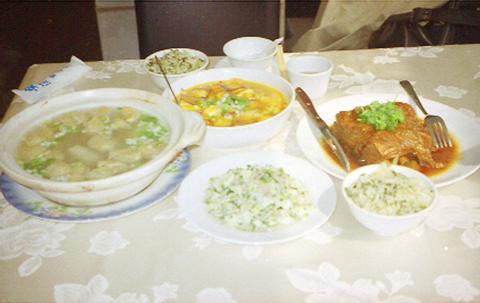Although recently given a bright shiny facelift in the form of a very modern glass facade and a characterless but poured concrete interior comparable to many of the city's eateries, the Southern-style Chinese cuisine cooked up at Lan Lao Lao (
The revamped joint has been serving up cuisine endemic to China's Zhejiang (
Regardless of the time of day diners choose to frequent Lan Lao Lao, it's the restaurant's pork dishes that take pride of place in any meal. And leading the way is the hongtsong kaopai, or ribs with red onion (紅蔥烤排). A small plate of which costs NT$400 and a large plate NT$800. A true taste sensation, the pork falls effortlessly from the bone and dissolves in the mouth, leaving little need for diners to exercise their jaw muscles.

PHOTO: GAVIN PHIPPS, TAIPEI TIMES
Not that the well-cooked parts of pig are the only dishes worth eating. The eatery also does some truly mouth watering things with tofu such as crab with tofu and hibiscus (
Another of the restaurant's trademark dishes is the hsuetsai paiyue (NT$150 for a small plate,
Along with the food, another point that sets Lan Lao Lao apart from the rest is the consistent manner in which the chefs are always on the ball. It doesn't matter how often diners chow-down at Lan Lao Lao; the food remains as well prepared and as appetizing on each visit.
It's not only the chefs who make eating out at Lan Lao Lao such a pleasure. The waitresses are cordial and are always happy to help diners unfamiliar with southern-style Chinese cuisine to choose their spread.

In the March 9 edition of the Taipei Times a piece by Ninon Godefroy ran with the headine “The quiet, gentle rhythm of Taiwan.” It started with the line “Taiwan is a small, humble place. There is no Eiffel Tower, no pyramids — no singular attraction that draws the world’s attention.” I laughed out loud at that. This was out of no disrespect for the author or the piece, which made some interesting analogies and good points about how both Din Tai Fung’s and Taiwan Semiconductor Manufacturing Co’s (TSMC, 台積電) meticulous attention to detail and quality are not quite up to

April 21 to April 27 Hsieh Er’s (謝娥) political fortunes were rising fast after she got out of jail and joined the Chinese Nationalist Party (KMT) in December 1945. Not only did she hold key positions in various committees, she was elected the only woman on the Taipei City Council and headed to Nanjing in 1946 as the sole Taiwanese female representative to the National Constituent Assembly. With the support of first lady Soong May-ling (宋美齡), she started the Taipei Women’s Association and Taiwan Provincial Women’s Association, where she

It is one of the more remarkable facts of Taiwan history that it was never occupied or claimed by any of the numerous kingdoms of southern China — Han or otherwise — that lay just across the water from it. None of their brilliant ministers ever discovered that Taiwan was a “core interest” of the state whose annexation was “inevitable.” As Paul Kua notes in an excellent monograph laying out how the Portuguese gave Taiwan the name “Formosa,” the first Europeans to express an interest in occupying Taiwan were the Spanish. Tonio Andrade in his seminal work, How Taiwan Became Chinese,

Mongolian influencer Anudari Daarya looks effortlessly glamorous and carefree in her social media posts — but the classically trained pianist’s road to acceptance as a transgender artist has been anything but easy. She is one of a growing number of Mongolian LGBTQ youth challenging stereotypes and fighting for acceptance through media representation in the socially conservative country. LGBTQ Mongolians often hide their identities from their employers and colleagues for fear of discrimination, with a survey by the non-profit LGBT Centre Mongolia showing that only 20 percent of people felt comfortable coming out at work. Daarya, 25, said she has faced discrimination since she